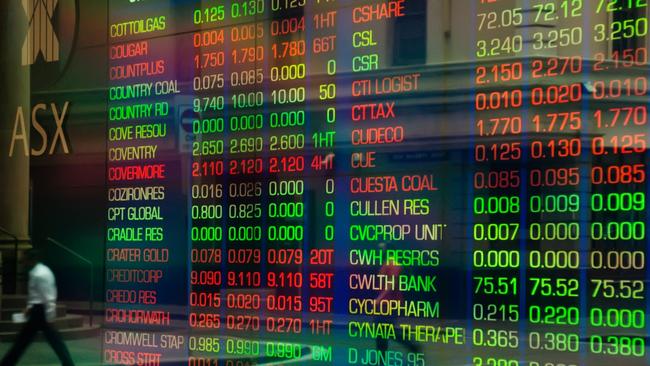Should I invest in shares, managed funds, ETFs or micro-investing?
A particular investment option has been getting heaps of attention from investors, with the amount of money skyrocketing by $40 billion in 12 months.
Investing
Don't miss out on the headlines from Investing. Followed categories will be added to My News.
It’s a common story. You work hard to save up a chunk of cash, and as the money grows, so does the feeling you should be making it work harder for you.
You know you should invest, but when it comes to actually pulling the trigger it’s super scary. You don’t want to make a mistake, or even worse do something dumb you regret later. You want to be smart.
But figuring out what the ‘smart’ move is for you is hard. There are so many options, shares, exchange traded funds (ETFs), micro-investing apps and managed funds – the number of choices is overwhelming.
When this overwhelm is combined with the fear of making a mistake it’s paralysing, and you can fall into the indecision and inaction trap. The unfortunate consequence is that when this happens you’re missing out on the opportunity to start building your money momentum.
But when you get this right, you put yourself in a position to make smart moves with confidence and ultimately take action and drive results.
The ETF market in Australia has been getting a heap of attention from investors, with statistics showing the amount of investor money in it has increased by over $40 billion in the last 12 months alone. But are ETFs the best move for you?
I’ve found one of the key areas would-be investors end up stalled is in choosing the actual investments they should use to start building their investment portfolio, so here I’ve covered the key options you need to understand so you can make the best choice for you.
Shares
When you buy shares, you’re buying a small slice of a company. Because you own a small piece of the company, when the value of the company grows, the value of your share grows with it. You’re also entitled to a small slice of any profits that are paid out to shareholders in the form of dividends.

A big advantage of buying shares is that you can choose a company you think is a good investment, and then if the company performs well you benefit. The downside of shares is that when you buy shares in one company, your risk is concentrated to just that company, i.e. your investment isn’t diversified.
The other downside is that the statistics show that it’s hard to consistently choose investments that will perform better than the average share market return.
Managed funds
A managed fund is a pooled investment that typically buys up a number of shares, where the investors share the costs and ultimately returns. The advantage of managed funds is that you can buy one investment that immediately gives you access to a large number of shares.
The downside of managed funds is that you don’t have as much control over how the money is invested, and the tax consequences of buying and selling shares is spread across investors.

Exchange traded funds
Exchange Traded Funds (or ETFs) have been growing in popularity over the last few years, and increasing just as quickly is the number of ETF options available to investors. ETFs are like a hybrid of shares and managed funds, where investors are able to get access to a bundle of shares and have more control over their tax outcomes.
The downside of ETFs is that because these are bought and sold on a share brokerage platform like CommSec, they typically come with a fixed brokerage cost every time you invest.
Micro-investing
Micro-investing apps and platforms like Raiz and Pearler have burst into the investment scene over the last decade or so and have become very popular for good reason. They have the advantage of combining a slick user experience with the ability to invest small amounts of money into shares, managed funds or ETFs.

The downside of micro-investing is having slightly less control of your investments, and when you have larger amounts to invest the fees can be higher than some of the alternatives.
How to choose
The reality is, when you’re in the early stages of your investment journey and don’t have a six-figure plus portfolio, the difference between shares, managed funds, ETFs, and micro-investing apps is going to be pretty small.
To me this suggests that when you’re making your investment choice, you should focus on a solution that’s easy for you to set up, use and navigate. This will put you in a position to take action sooner so you can start getting results.
I should call out that if you’re intending to invest a sizeable amount of money either as an initial contribution or regularly moving forward, making the best choice at this point will pay big dividends over time – if this is you, think about doing some research or getting some good professional advice.
The wrap
The amount of choices out there can be overwhelming, and can be a huge barrier to taking action and getting results. But only if you let it.
Take the time to understand your options and how to make the right choice for you, and you’ll go a long way to building the confidence to make your investing goals happen.
Ben Nash is a finance expert commentator, podcaster, financial adviser and founder of Pivot Wealth, and author of the Amazon best-selling book ‘Get Unstuck: Your guide to creating a life not limited by money’.
Ben has just launched a series of free online money education events to help you get on the front financial foot. You can check out all the details and book your place here.
Disclaimer: The information contained in this article is general in nature and does not take into account your personal objectives, financial situation or needs. Therefore, you should consider whether the information is appropriate to your circumstances before acting on it, and where appropriate, seek professional advice from a finance professional.
Originally published as Should I invest in shares, managed funds, ETFs or micro-investing?





